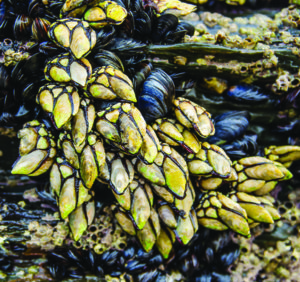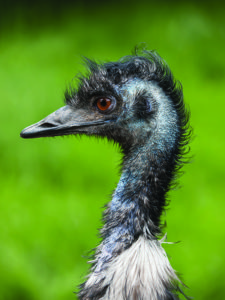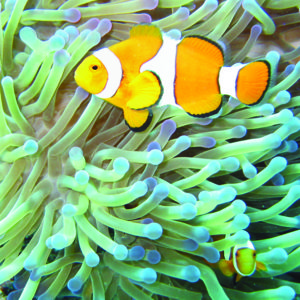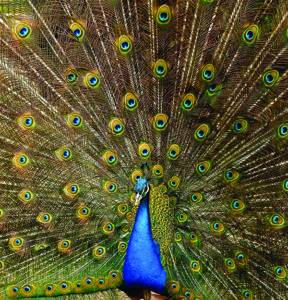Everything You Know about Sex Is Wrong Part 1: The Gender Binary

This article has been adapted from the talk I gave on June 10, 2017, at the 76th Annual Conference of the American Humanist Association in Charleston, South Carolina. Because all of humanity’s misconceptions about sex couldn’t possibly be contained in a single talk, I call it “Part I,” leaving room for further explorations of this subject.
The Original Sex
IN THE BEGINNING it was Adam and Eve, not Adam and Steve.” I don’t know if you heard that bad excuse for homophobia growing up, but I did. The problem is that it’s wrong in every possible way. There’s absolutely nothing correct about that statement.
So let’s start again and do it right: In the beginning there was one sex, and it was female.
An individual reproduced by growing a copy of herself and releasing that copy into the environment. This was certainly the case with the first self-copying molecule. Since life began with the first self-copying molecule, this means females are the first, original sex. In the beginning it wasn’t Adam and Eve—it was Eve.
In biblical terms, Eve begat Eve and Eve and Eve, and one of those Eves had a mutation—that is, a slight genetic change—and begat a line of Evelyns. Some of these mutated further and begat lines of Ediths and Ednas. Meanwhile, the Eves were still busy begetting more Eves, but some of those mutated and became Esmes and Esmereldas. So females were really doing pretty well before males came along, thank you very much.
The problems began when two of Eve’s daughters—let’s call them Edith and Esmerelda—started competing with each other. And thus the evolutionary arms race began. The problem was made worse by the fact that Edith continued to mutate and got new advantages over Esmerelda. Meanwhile, poor Esmerelda didn’t always mutate fast enough to keep up. Many strains of Esmereldas were wiped out because of this, and that was the end of their evolutionary line.
But then a mutation took place that allowed some Esmereldas to swap genes with other members of the population. Members who were not Esmereldas. And this gene-swapping saved the day. That’s because some of these newly acquired genes allowed the New Esmereldas to compete successfully with that pesky Edith. True, the New Esmereldas were no longer pure Esmereldas, but by golly they were alive. So the New, Improved Esmereldas got ahead in the evolutionary arms race. And that is how sex was born. And it was good.
According to evolutionary biologist W.D. Hamilton, one major benefit of sexual reproduction is the ability to stay ahead of parasites. Parasites work by adapting precisely to a very specific host species. The only potential hosts that are likely to survive are those that have the ability to mix their genetics quickly through sexual reproduction and spread beneficial mutations through the population quickly, also by sexual reproduction.
Other biologists have also suggested that the gene exchange done by sexual reproduction also means that siblings are not exact copies of one another and are therefore less likely to compete directly with one another for survival. But one way or another, that’s what males are for. Males are genetic mixers. They speed up evolutionary change.
Male Sexual Strategies
Since a male’s genes can only survive by contributing to somebody else’s reproduction, males have evolved a wide variety of mechanisms for trying to persuade a female to mate with them.
There’s showing off. Everybody knows about peacocks using their tails to attract mates, but did you know about technicolor vomit? Crustaceans called ostracods vomit luminous mucous in order to attract mates. Isn’t that sexy?
There’s showering females with gifts. Humans do this. Did you know that bowerbirds do too? Male bowerbirds make really showy nests in order to attract females.
 There’s also trapping females. Trapping females is also known as rape. Rape is immoral, but evolution should never be taken for a good moral code. People sometimes get confused about this, but the natural phenomenon of evolution doesn’t have good morals or bad morals any more than gravity has good morals or bad morals.
There’s also trapping females. Trapping females is also known as rape. Rape is immoral, but evolution should never be taken for a good moral code. People sometimes get confused about this, but the natural phenomenon of evolution doesn’t have good morals or bad morals any more than gravity has good morals or bad morals.
There’s growing longer penises than the competition. This is what barnacles do. Because barnacles are stationary as adults, getting sperm to the nearest female is a challenge for males. To meet the challenge and compete, male barnacles can grow penises up to eight times the length of their own bodies. (Remember this the next time somebody brags about the size of theirs.)
Assumptions about Nature and Sex
Some people spend a whole lot of time telling each other what kind of sex is “natural” and what kind of sex is “unnatural.” But as I’ve discussed here, sexual reproduction only exists as a means of genetic mixing and doesn’t require a specific set of gender or sexual characteristics. Here are a number of assumptions people have about sex and gender that are proven wrong by males, females, and other forms throughout the animal kingdom. The point is there’s no one set of rules—sexuality is a free-for-all.
 Mistaken Assumption #1: “Evolution means that males have no parental involvement and leave care of the infants and children to females, right?” Wrong. Here’s just one example: emus, the big flightless birds from Australia. Once the female lays her eggs, the male emu is the one who incubates them. Once the eggs hatch, the male raises the chicks.
Mistaken Assumption #1: “Evolution means that males have no parental involvement and leave care of the infants and children to females, right?” Wrong. Here’s just one example: emus, the big flightless birds from Australia. Once the female lays her eggs, the male emu is the one who incubates them. Once the eggs hatch, the male raises the chicks.
Mistaken Assumption #2: “Doesn’t evolution mean that males will always be bigger than females and will dominate them?” Not always. For instance, male anglerfish are tiny compared to females. In fact, to continue their existence past a certain age, a male anglerfish must attach himself to a female and fuse his body with hers. Some female anglerfish have two or more attached males.
In the biological sciences, having different sexes of different sizes is called sexual dimorphism. You can tell that the people who invented this term were men, since the term sexual dimorphism is defined as males being bigger than females. When the females of a species are larger than the males, this is called reverse sexual dimorphism. In other words, human male biologists just assumed that males being bigger than females was the natural state of being.
Mistaken Assumption #3: “Males are always the ones with Y chromosomes.” In fact, all male birds have two X chromosomes; it’s the females who have the Y chromosome. This is true for some male insects like moths and butterflies as well, and some crustaceans and reptiles, including the huge lizards called Komodo dragons. It’s called the ZW system instead of the XY system, but that’s just to make it easier for people to talk about it.
Mistaken Assumption #4: “Fem-ales and males have separate bodies, right?” Wrong. Many animals are hermaphrodites. That is, they have both male and female reproductive organs. Most snails are hermaphrodites. So are many jellyfish and many worms.
Mistaken Assumption #5: “Male input is always required for reproduction.” No. Bonnethead sharks, blacktip sharks, leopard sharks, zebra sharks, small white-spotted bamboo sharks, many snakes (including boa constrictors), and fifty species of lizards can all reproduce without males.
 Mistaken Assumption #6: “We always see depictions from the Bible of animals being saved from Noah’s flood by going on the ark, two by two. One female and one male. That’s what’s natural, right?” Wrong. Many species have some male homosexual individuals. Take rams, for instance. That very symbol of raging male horniness—the ram—is a male sheep. About 8 percent of all rams form exclusively male-to-male pair bonds, forsaking all contact with female sheep.
Mistaken Assumption #6: “We always see depictions from the Bible of animals being saved from Noah’s flood by going on the ark, two by two. One female and one male. That’s what’s natural, right?” Wrong. Many species have some male homosexual individuals. Take rams, for instance. That very symbol of raging male horniness—the ram—is a male sheep. About 8 percent of all rams form exclusively male-to-male pair bonds, forsaking all contact with female sheep.
Some animals routinely practice lesbianism. For example, the Laysan species of albatross has many same-sex female pairs who nest and raise chicks together.
Other animals form trios, in some cases for childrearing. Skuas are seabirds that often nest as mixed-sex trios and raise chicks together. Some trios are for sex. For example, a female North Atlantic right whale was photographed having sex with two males at once, which is an example of a multi-male breeding system, where each female may have many male partners. There are also multi-female breeding systems where one male may have many female partners. A male northern fur seal, for example, will mate with many females. (Just like in the Old Testament!)
What about nonhuman primates? It turns out that our near relatives in the animal kingdom have all different kinds of breeding systems. Some species have multi-male breeding systems, some have multi-female breeding systems, and some have monogamous breeding systems. Furthermore, homosexuality, lesbianism, and bisexuality are all found within nonhuman primate species.
Mistaken Assumption #7: “At least males are males and females are females…none of this cross-dressing or transgender stuff, right?” Wrong. Transgender fish are common! The Barramundi transition from male to female. Most mature as males and become female after one or more spawning seasons. Most of the larger specimens are therefore female.
Blue gropers (an ocean fish) change from female to male. It’s the males that are blue. Usually, you will only find only one or two male blue gropers in an area, and a larger number of female gropers in the same area. Then, when the dominant male dies, the largest female grows, changes color and sex, and becomes the dominant male.
 Clownfish change from whatever to male or female (yes, Nemo himself was gender-fluid). They start life with no functioning gonads. There is one breeding pair, with a large female, a smaller male, and a bunch of non-sexual, or sometimes male, smaller individuals. If the female dies, then the male becomes female. If the male dies, then the largest non-breeding fish becomes male.
Clownfish change from whatever to male or female (yes, Nemo himself was gender-fluid). They start life with no functioning gonads. There is one breeding pair, with a large female, a smaller male, and a bunch of non-sexual, or sometimes male, smaller individuals. If the female dies, then the male becomes female. If the male dies, then the largest non-breeding fish becomes male.
Dwarf hawkfish are even more gender-fluid, living in harems with one dominant male mating with several females. When it comes to sex change, the size of the harem matters. If a male hawkfish takes on too many females, then one of the largest females will change sex, become male, and take over half of the harem. But, if that new male hawkfish loses a few females to other harems and is challenged by a larger male, then it goes back to being female. That way it doesn’t lose precious energy fighting a losing battle. So the ability to change sex in both directions maximizes an individual’s ability to reproduce, at least for the dwarf hawkfish.
Mistaken Assumption #8: “Genderfluidity is real, but at least there are two sexes.” Wrong again. Meet Tetrahymena thermophila, the organism with the most creative sex life I know of, with seven sexes. You heard me—seven!
This single-celled creature, which has been thoroughly studied by biologist Eduardo Orias, mostly reproduces without sex, dividing into two identical daughter cells. (That’s Eve begetting Eve again.) But when food is scarce the organism can opt for sexual reproduction, which—as I told you before—creates novel genetic combinations that may give daughter cells a better chance of surviving in a harsh environment.
Such tough conditions also rewarded the organisms when they developed more sexes—because it gave them more mating opportunities. After all, if you only have two sexes, there’s only a 50 percent chance that someone you meet will be of the right type. But with seven different sexes, a creature’s chance of meeting Ms. or Mr. Right increases to about 85 percent—much better odds than 50 percent, so seven sexes wins.
What We Now Know
So falls the argument from nature. In its place is the knowledge that there’s no such thing as an “unnatural” gender role. We know that any time a religion—or anyone claiming moral authority—says non-heterosexual sex is wrong because it’s unnatural, this is a lie. We know that we cannot allow the idea of what’s “natural” to be used as an excuse for the mistreatment of women, or men, or anybody in the LGBTQ+ community. We know that men don’t have god-given dominion over women, and humans don’t have god-given dominion over anything.
The earth and the living things on it are holy. That is, they are worthy of supreme respect. Not because they are supernatural, but because they are alive, and that is amazing and precious enough.

